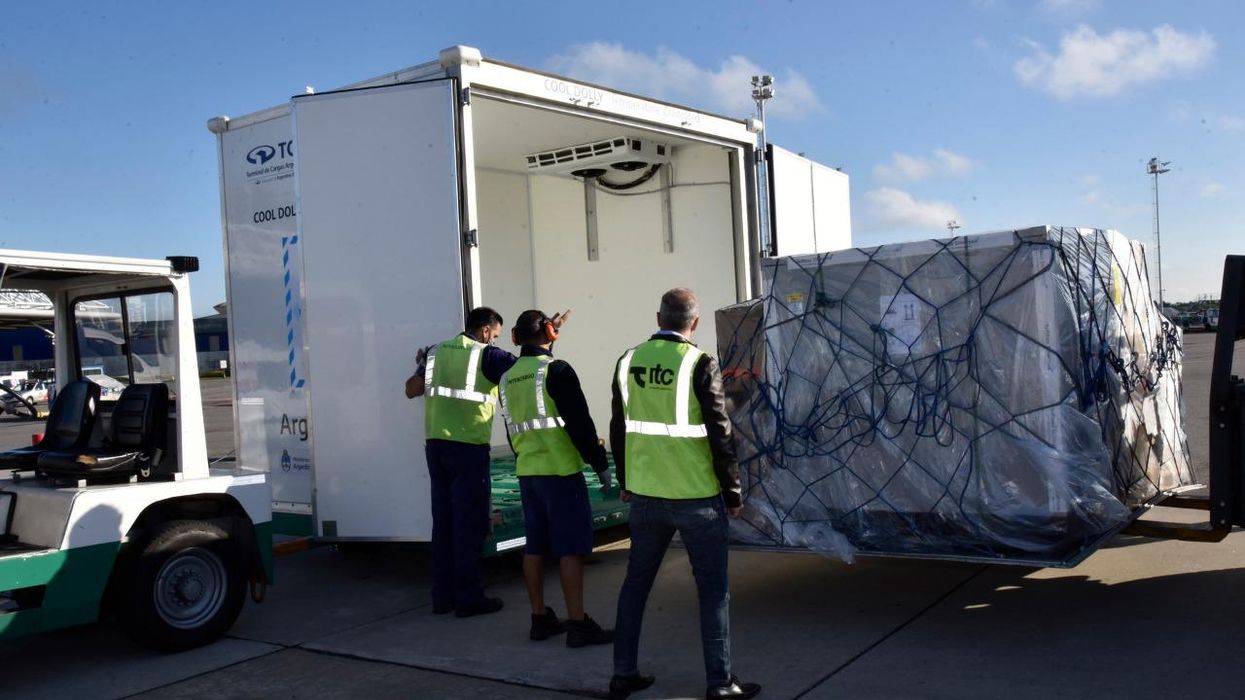COVID Deaths Are Falling In US, But Global Mortality Estimates Are Far Too Low

Oxford/AstraZeneca vaccines arriving in Argentina.
Reprinted with permission from Daily Kos
Earlier this month, a study out of theInstitute for Health Metrics and Evaluation (IHME) projected the actual number of COVID-19 deaths in the United States at over 900,000—far above the official numbers listed by the Centers for Disease Control and Prevention or state agencies. While that study was based on projections and evaluation of excess mortality in 2020, it seems to be validated by numerous reports of deaths that were overlooked or never evaluated, especially those occurring outside hospitals.
The IHME study suggested that the same massive undercount was likely to be true around the world, and now the World Health Organization is saying something very similar. At this point, total global deaths from COVID-19 may be between 6 and 8 million—twice the official value of 3.4 million. That still doesn't put this pandemic on par with the 1918-1919 flu pandemic, which killed at least 17 million, but the higher number makes COVID-19 not just the worst pandemic in a century, but among the largest pandemics over a much longer period.
In other words, if the last 18 months has seemed like a truly unusual period, that's because it has been. And as better numbers appear conveying the huge scope of what has happened, it becomes more important to recognize the measures that had, so far at least, prevented COVID-19 from climbing the chart of all-time human disasters.
As The New York Times reports, at least 3 million people in the the 6-8 million death estimate are believed to have died before the end of 2020, compared to a reported total of 1.8 million. In the United States cases of COVID-19 may have peaked in the first weeks of January, but around the globe, cases reached an even larger peak in April and are only now starting to drop as case counts in beleaguered India decline.
India is one of those nations where the official totals are expected to diverge most widely from genuine losses. Total deaths there are still listed at less than 300,000—about half the official total for the United States—but each day of the shocking spike in cases that began at the end of March has produced reports of thousands of uncounted deaths. On some days, local officials reported more deaths in a single city than the official records recorded for the nation. How, or if, all of this will eventually be reconciled is an open question.
The other thing that needs to be considered is that the pandemic is not over. No matter how many stories run about Europe reopening for tourists, or mask mandates being dropped across America, the areas that have already experienced widespread COVID-19 are just a subset. Many countries in Africa had little experience of the disease through the last year. In Asia, a number of nations that appeared to have "beaten COVID-19" are now seeing record levels of cases as world travel increases and new variants are spread.
Just looking at a few relatively wealthy nations, it's easy to see that the level of vaccination around the world varies widely.
 Even nations with access to COVID-19 vaccine have a huge disparity in levels of vaccination. attribution: Our World In Data
Even nations with access to COVID-19 vaccine have a huge disparity in levels of vaccination. attribution: Our World In Data
Across Africa, there are more than two dozen nations where less than 2% of the population has been vaccinated. Many of these nations either have no reserve of vaccine, or may be getting vaccines that are significantly less effective than those being passed around wealthier nations.
Regardless of how the epidemic of cases shaped up in the U.S., a chart of reported cases around the world shows why this pandemic isn't anywhere close to over.

Global daily cases of COVID-19 remain high, and the trend is still going up. attribution: WorldOMeters
New cases of COVID-19 around the world are exceeding half a million. The overall trend in cases remains an upward one. Only a tiny fraction of the world has been vaccinated, and most of that fraction is concentrated in a few wealthy nations. Not only does the potential exist for this pandemic to get much worse across the globe, the huge reservoir created by all these cases provides plenty of raw material for new, more dangerous variants.
Getting vaccine not just delivered to other nations, but into the arms of the world's population, is a national security issue for the United States.
- Trump Officials Boasted Of Distorting CDC Reports On Pandemic ... ›
- Compulsory Vaccination Is American As Apple Pie — And Old As ... ›
- GOP Anti-Vaxxers Are Destroying America's Hope For Herd ... ›
- Let's Mock The Idiots Who Think Vaccines Are More Dangerous ... ›
- Far-Right Prime Minister Culpable For India's Pandemic Disaster ... ›
- Suspend Those Vaccine Patents Now - National Memo ›
- Why Nobody Is Accountable For The Global Vaccination Fiasco ... ›
- How To Survive A Global Pandemic - National Memo ›
- Our Big Chance To Do The Noble Thing, Again - National Memo ›
- Institute for Health Metrics and Evaluation | ›
- Covid-19 mortality rates are falling worldwide, but scientists worry ... ›
- Why measles deaths are surging — and coronavirus could make it ... ›
- More Than 1.57 Billion Shots Given: Covid-19 Vaccine Tracker ›
- India Continues Shattering Virus Records as World Pledges Aid ... ›
- Covax: How will Covid vaccines be shared around the world? - BBC ... ›
- New analysis finds global Covid death toll is double official estimates ›
- Global COVID-19 death toll more than double official estimates ... ›








